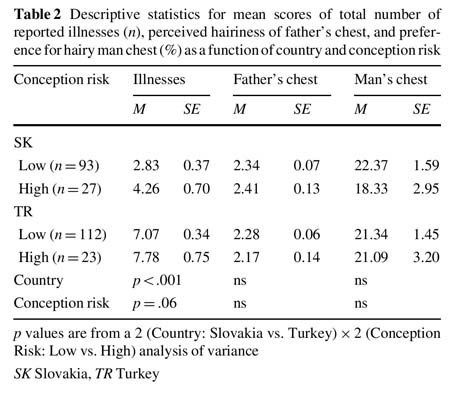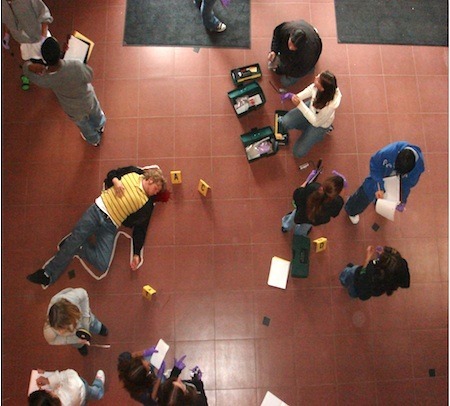Marc Abrahams's Blog, page 456
October 16, 2013
“Is a Woman’s Preference for Chest Hair in Men Influenced by Parasite Threat?”
Comes a new international investigation of whether women prefer men without chest hair, and whether that preference is in some way due to the presence, now or in daddy’s heyday, of parasites in the region. Disgust enters the picture. Much ado there is:
“Is a Woman’s Preference for Chest Hair in Men Influenced by Parasite Threat?” Pavol Prokop [pictured here with his chest covered by clothing], Markus J. Rantala, Muhammet Usak, Ibrahim Senay,” Archives of Sexual Behavior, October 2013, Volume 42, Issue 7, pp 1181-1189. The authors, at Trnava University, Slovakia, Slovak Academy of Sciences, Bratislava, University of Turku, Finland, Dumlupinar University, Kutahya, Turkey, and Zirve University, Gaziantep, Turkey, explain:
“Our primary goal was to examine the “ectoparasite avoidance mediated by mate choice hypothesis” suggesting that women prefer men lacking chest hair in order to avoid ectoparasite loads. We predicted that women living in areas with high prevalence of pathogens (n = 161) would be less likely to show a preference for a male with chest hair in comparison with women living in areas with low pathogen prevalence (n = 183). We found that overall preference for man chest hair was low, but there were no significant associations between perceived vulnerability to diseases or disgust sensitivity and preference of men who have had experimentally removed chest hair. Women who lived in an environment with a high parasite prevalence rate (Turkey) showed a similar preference for man chest hair as did women from an environment with low parasite prevalence (Slovakia). The participants biological fathers’ chest hair had no significant effect on their preference for men with chest hair. Women living in a high-parasite-prevalence environment reported a higher disgust score in the sexual domain and more recent experiences with illnesses, suggesting that parasites influence sensitivity to sexual disgust. These results provide no support for the ectoparasite avoidance hypothesis mediated by mate choice and suggest that shaved men bodies are preferred more by women.”
Further details from the study:
 (Thanks to investigator Brenda Chavez for bringing this to our attention.)
(Thanks to investigator Brenda Chavez for bringing this to our attention.)
BONUS: Co-author Rantula is co-author of the forthcoming study ”Hissing calls improve survival in incubating female great tits (Parus major),” Krams, I, Jolanta Vrublevska, J, Koosa K, Krama, T, Mierauskas P, Rantala M.J. & Vallo Tilgar, V. Acta Ethologica, in press.

Quantum Holographic Critical Criminology
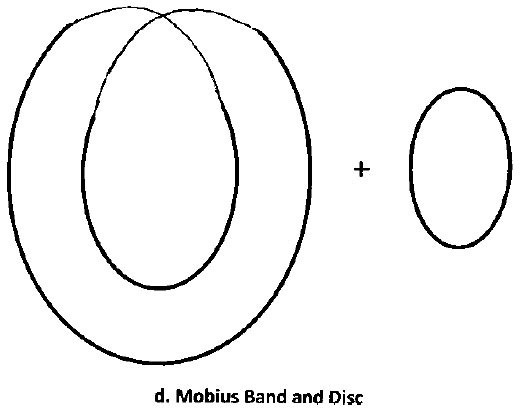 A bicycle is stolen, it later reappears in another place. A likely explanation is that the bicycle was unlawfully moved (as a unified and coherent macro-collection of atoms and molecules) by the thief. But not all criminologists are happy with such broad-brushed Newtonian descriptions of events. Take for example professor Dragan Milovanovic of Northeastern Illinois University, US, who points out that :
A bicycle is stolen, it later reappears in another place. A likely explanation is that the bicycle was unlawfully moved (as a unified and coherent macro-collection of atoms and molecules) by the thief. But not all criminologists are happy with such broad-brushed Newtonian descriptions of events. Take for example professor Dragan Milovanovic of Northeastern Illinois University, US, who points out that :
“Criminology is missing a subject. It is time to consider new tools for inquiry. We don’t look far to see the failures of our criminal justice system. We need to move forward with a new sense of urgency and conviction.”
Thus the professor introduces, for the first time, the concept of Quantum Holographic Critical Criminology in the Journal of Theoretical and Philosophical Criminology, July, 2013, Vol. 5(2): pp. 1 – 29.
“Quantum holographic theory is offering novel understandings well understood in other disciplines. It is time for the process-information paradigm to be addressed in criminology and the social sciences.”
The paper considers the criminological implications of “backward time referral” along with “spin networks” and “molar assemblages”. In doing so, it not only cites the works of Freud, Deleuze, Guattari, Lacan, Delanda, Bruza, Kitto, Dirac, Marcer, Schempp, and Bergson, but also Einstein, de Broglie, Schroedinger, Jung, Penrose, Wheeler, Pribram, Witten, Erikson and many more.
[Note: Given the extremely enigmatic nature of any quantum-based inquiry, it's fitting, perhaps inevitable, that the key points of such a concept are hard (for us) to summarize in a simple way. Thus, Improbable strongly encourages readers to read the full paper via the link above. Please feel free to comment if you can provide a summary for us (limit 140 characters)]

October 15, 2013
Geim’s surprises about (1) materials and (2) a historic hamster
Andre Geim, interviewed in YourIs, reveals two surprises, one speculating about materials he intends to study, the other about the existence of a predecessor to the celebrated levitating frog:
Andre Geim: graphene is only the beginning
Andre Konstantin Geim is the only person who ever received both a Nobel and an Ig Nobel [editor's note: this almost — but not quite — correct. Geim is the only person to have been individually awarded one of each]…
Geim is already looking in a more distant future. He thinks that probably, much more materials exist, that in structures with only one layer of atoms have surprising properties. “I don’t believe this is only the case for carbon varieties, but also for other elements of the periodic system and even for complex molecules. I suggest we should look again at mica.” ..
Geim underlines the importance of thinking ‘out of the box’ and ‘trial and error’ experiments. This approach is not only a reference to his mechanical graphene peeling, but also to his Ig Nobel work. The Ig Nobel Prizes are given for unusual or trivial scientific research achievements making people laugh, before they make them think. Geim won this prize together with Mike Berry, for the levitation of a little frog in a strong magnetic field. “First we used a hamster. After we saw the hamster didn’t like it, we took a frog.” Whether the frog liked the experiment, Geim does not know. The hamster, dubbed H.A.M.S. ter Tisha, was rewarded with a co-authorship of the research paper. The frog still remains anonymous.

Ig Nobel Services Provided This Year to Security Agencies
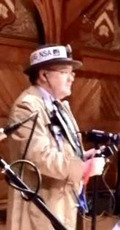
The NSA Courtesy Cam operator operating the NSA Courtesy Cam at the 20013 Ig Nobel Prize Ceremony (photo by Julia Lunetta)
As co-producer of the annual Ig Nobel Prize Ceremony, I know that we have more than one audience — one in the seats of Harvard’s historic Sanders Theatre, and one watching our live broadcasts online from around the world.
In the spirit of experimentation, and perhaps even of constant improvement, the 2013 Ig Nobel Prize ceremony (see the full video or ceremony details) included several new services to help both these audiences. Among those were two of note:
For our off-site audience we offered our NSA Courtesy Cam and IG_NSA twitter feed. We hope that this was useful for any security agencies concerned that the official broadcast did not include enough information. We also hope that no one was too alarmed that the man in charge of this extra information had a British accent.
For our in-theatre audience we offered the Ig Nobel Information Desk in the theatre’s lobby. We are very happy that so many people came to this desk and hope that none of them were too alarmed to discover that the desk was there to collect information rather than to dispense it. We understand why they may have thought that the desk would work the other way.
The desk was very ably staffed by our Information Liaison, Dr. Jenny Gutbezahl, a researcher, consultant, and author in the field of collecting information. Dr. Gutbezahl listened to everything that people told her at the Information Desk, and attempted to group that everything into categories for us.
Her first category concerned the people who came to the table believing that they would receive information there rather than give it, and gave information that concerned the information they had hoped to receive.
• There was a Japanese Laureate; he’s married and I’m trying to find his wife
• I’m looking for the will call; I will be sad if I can’t find the will call
• I need a place to leave a ticket
Here are Dr. Gutbezahl’s other categories, with select examples:
Some people gave local or Ig-specific information
•The Turkey Sub is Very Delicious
•I was just taught how to fold a paper hat out of a Japanese newspaper
•It’s very hot in here
•The cioppino at Legal Seafood is pretty tasty
A few people gave specific factual information
• Science will be publishing the results of a major sting operation the first week of October
• Tony Kubek played shortstop for The Yankees in 1959
Two people got into an argument about where the solar system ends
• Voyager One has officially left the solar system
• No – it left the heliosphere; it’s still within the gravitational pull of the Sun.
• The solar system ends at the termination shock!
• No it doesn’t!
• Agreed as valid information: Voyager one is definitely in a denser region of plasma
A few people were unable to provide any information
• We’re not very good information generators
• The Hypotenuse… that’s all I’ve got
Several people gave personal information
• My name is Diana
• My name is Jeannie Austin
• I have blue eyes
• My last name is MacIntosh
• My dog’s name is Buster; he’s a French Bulldog
Thanks to Dr. Gutbezahl and to all those who supplied her with information. We hope that people can agree on a common definition for “solar system” in the near future.

The Ig Nobel Information Desk (not pictured here) was located in the transept of Sanders Theatre, where audience members (not pictured here) lingered before entering the theater proper (not pictured here). (Photo by David Kessler)

Drug experiment of the day: Cocaine and Oreo Cookies
Today’s Drug Experiment of the Day happened at the University of Connecticut. Connecticut College News announces:
In a study designed to shed light on the potential addictiveness of high-fat/ high-sugar foods, Professor Joseph Schroeder [pictured here] and his students found rats formed an equally strong association between the pleasurable effects of eating Oreos and a specific environment as they did between cocaine or morphine and a specific environment….
(Thanks to investigator William J. Maloney for bringing this to our attention.)
BONUS: Video of a man eating Oreo cookies:

Puzzling Experiment of the Day: Mock Crime Blink
Today’s Puzzling Experiment of the Day is described in this paper:
“Detecting false intent using eye blink measures,” Frank M. Marchak [pictured here], Frontiers in Psychology, 4 (2013): 736. (Thanks to investigator Neil Martin for bringing this to our attention.) The author, at Veridical Research and Design Corporation, Bozeman, MT, USA, explains:
“Here we examined—across two experiments with increasing degrees of ecological validity—whether changes in eye blinking can be used to determine false intent regarding future actions. In both experiments, half of the participants engaged in a mock crime and then transported an explosive device with the intent of delivering it to a “contact” that would use it to cause a disturbance.”
BONUS (unrelated): New Mexico Tech’s “Teacher Tips for Implementing a Mock Crime Scene ”, which includes this photo:

October 14, 2013
The Abnormality of Normality
O’Boyle and Aguinis want you to know a little something about normality. Thus they produced this study:
“The Best and The Rest: Revisiting the Norm of Normality of Individual Performance,” Ernest O’Boyle Jr., Herman Aguinis [pictured here], Personnel Psychology, vol. 65, no. 1, Spring 2012, pp. 79–119. The authors, at Longwood University and Indiana University, explain:
“We revisit a long-held assumption in human resource management, organizational behavior, and industrial and organizational psychology that individual performance follows a Gaussian (normal) distribution. We conducted 5 studies involving 198 samples including 633,263 researchers, entertainers, politicians, and amateur and professional athletes. Results are remarkably consistent across industries, types of jobs, types of performance measures, and time frames and indicate that individual performance is not normally distributed—instead, it follows a Paretian (power law) distribution. Assuming normality of individual performance can lead to misspecified theories and misleading practices. Thus, our results have implications for all theories and applications that directly or indirectly address the performance of individual workers including performance measurement and management, utility analysis in preemployment testing and training and development, personnel selection, leadership, and the prediction of performance, among others.”

A Wetsuit for a Penguin
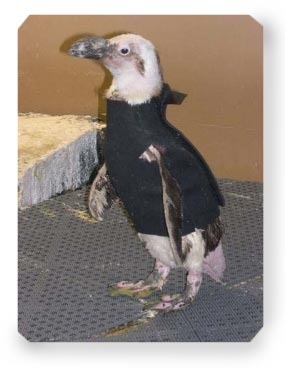 Pierre the plumage-challenged penguin needed some protection from the cold whilst swimming in chilly waters. A bespoke wetsuit was fashioned for him by Pamela Schaller, Senior Aquatic Biologist at the California Academy of Sciences, Steinhart Aquarium, US.
Pierre the plumage-challenged penguin needed some protection from the cold whilst swimming in chilly waters. A bespoke wetsuit was fashioned for him by Pamela Schaller, Senior Aquatic Biologist at the California Academy of Sciences, Steinhart Aquarium, US.
Pierre’s story – with pics — is here, in Schaller’s paper called “How and Why to Make a Wetsuit for a Penguin“.

October 13, 2013
Birth-Fluid Dynamics, and the Splashy Hydrodynamics of Urination
Aatish Bhatia (of Empirical Zeal) alerts us to an outpouring of soon-to-be-announced birth-centric and micturation-modulation fluid dynamics insights.
 Anne Staples [pictured here], of Virginia Polytechnic Institute and State University, will chair a session on “Pumping Phenomenon“, at the American Physical Society’s 66th Annual Meeting of the APS Division of Fluid Dynamics,in Pittsburgh, Pennsylvania, on Sunday, November 24, 2013.
Anne Staples [pictured here], of Virginia Polytechnic Institute and State University, will chair a session on “Pumping Phenomenon“, at the American Physical Society’s 66th Annual Meeting of the APS Division of Fluid Dynamics,in Pittsburgh, Pennsylvania, on Sunday, November 24, 2013.
Three sub-topics highlight the affair:
“The Role of Amniotic Fluid in Force Transfer During Human Birth,” Alexa Baumer, Andrea Lehn , Megan Leftwich. The researchers, from George Washington University, will elaborate on this abstract (which might, we suggest, give insight also into the engineering of the Blonsky Birthing Device):
“This study seeks to understand the fundamental fluid dynamic processes involved in human birth. We begin by examining the importance of amniotic fluid. This is done using two experimental techniques that approximate the laboring human uterus to different degrees of anatomical correctness. The first, in which a latex uterus is filled with fluid and a solid fetus is extracted, investigates the importance of both amniotic fluid properties and fetal position in the force required to remove a fetus. The second experiment simplifies the geometry of birth even more. In this case, a solid cylindrical rod is pulled through a highly flexible outer tube. The force to pull the inner cylinder as a function of the gap fluid properties is measured. By carefully controlling the fluid properties of the experiment, the study will provide further insight into the roles of amniotic fluid in human birth.”
“The Hydrodynamics of Urination: to Drip or Jet“, Jonathan Pham, Patricia Yang, Jerome Choo, David Hu. The researchers, from Georgia Institute of Technology, will elaborate on this abstract:
“The release of waste products is fundamental to all life. How are fluids released from the body quickly and efficiently? In a combined experimental and theoretical investigation, we elucidate the hydrodynamics of urination across five orders of magnitude in animal mass. Using high-speed videography and flow-rate measurement at the Atlanta Zoo, we report discrete regimes for urination style. We observe dripping by small mammals such as rats and jetting by large mammals such as elephants. We discover urination duration is independent of animal size among animals that use jetting. We rationalize urination styles, along with the constant-time scaling, by consideration of the relative magnitudes of the driving forces, gravity and bladder pressure, and the corresponding viscous losses within the urethra. This study may give insight into why certain animals are more prone to diseases of the urinary tract, and how the urinary system evolved under the laws of fluid mechanics.”
“Urinal Dynamics“, Randy Hurd, Kip Hacking, Benjamin Haymore, Tadd Truscott. The researchers, from Brigham Young University, will elaborate on this abstract:
“In response to harsh and repeated criticisms from our mothers and several failed relationships with women, we present the splash dynamics of a simulated human male urine stream impacting rigid and free surfaces. Our study aims to reduce undesired splashing that may result from lavatory usage. Experiments are performed at a pressure and flow rate that would be expected from healthy male subjects. For a rigid surface, the effects of stream breakup and surface impact angle on lateral and vertical droplet ejection distances are measured using high-speed photography and image processing. For free surface impact, the effects of velocity and fluid depth on droplet ejection distances are measured. Guided by our results, techniques for splash reduction are proposed.”

Food Safety: Vanilla-like, from the Butt of Beavers
A flavorant from the butt of beavers underwent a safety assessment:
“Safety Assessment of Castoreum Extract as a Food Ingredient,” Ge0rge A. Burdock [pictured here], International Journal of Toxicology, vol. 26, no. 1, 2007, pp. 51-55. The author, of the Burdock Group, Washington, DC, explains:
“Castoreum extract (CAS NO. 8023–83–4; FEMA NO. 2261) is a natural product prepared by direct hot-alcohol extraction of castoreum, the dried and macerated castor sac scent glands (and their secretions) from the male or female beaver. It has been used extensively in perfumery and has been added to food as a flavor ingredient for at least 80 years. Both the Flavor and Extract Manufacturers Association (FEMA) and the Food and Drug Administration (FDA) regard castoreum extract as generally recognized as safe (GRAS). Acute toxicity studies in animals indicate that castoreum extract is nontoxic by both oral and dermal routes of administration and is not irritating or phototoxic to skin. Skin sensitization has not been observed in human subject tests. Castoreum extract possesses weak antibacterial activity. A long historical use of castoreum extract as a flavoring and fragrance ingredient has resulted in no reports of human adverse reactions. On the basis of this information, low-level, long-term exposure to castoreum extract does not pose a health risk. The objective of this review is to evaluate the safety-in-use of castoreum extract as a food ingredient.”
Beaver butt secretion good for baking: agency
The Swedish National Food Agency (Livsmedelsverket) has confirmed that anal secretions from the beaver can be used to provide a taste similar to vanilla in baked goods and sweets.
Information that beaver bottoms can be a source of vanilla aroma, in the form of Castoreum, have been circulating on the internet recently and the agency has now confirmed that there is substance to the secretions.
“Natural aromas can be extracts from plants, fungi, and in some cases animals. The labelling provisions do not require that the kind of flavour is indicated, with the exception of coffee and quinine,” Ulla Beckman Sundh at the agency said.
Vanilla flavour, it has been established, is not only derived from the vanilla bean. It can also come from conifer trees, or indeed from the anal passage of a beaver….
BONUS (about an alternate source material for vanilla flavor): The 2007 Ig Noble Prize for chemistry was awarded to Mayu Yamamoto of the International Medical Center of Japan, for developing a way to extract vanillin — vanilla fragrance and flavoring— from cow dung. [REFERENCE: "Novel Production Method for Plant Polyphenol from Livestock Excrement Using Subcritical Water Reaction," Mayu Yamamoto, International Journal of Chemical Engineering, vol. 2008.]

Marc Abrahams's Blog
- Marc Abrahams's profile
- 14 followers


